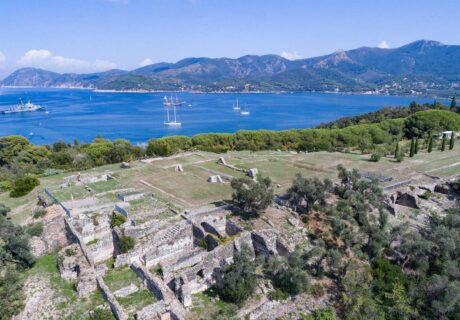The Garfagnana villages not to be missed
6 min · 29 May 2023

Situated between the Apuan Alps and Versilia, Garfagnana offers countless opportunities for those who love spending their holidays in the open air. But there is more besides nature. In this territory, rich in history and tradition, there are also countless villages where time seems to have stopped in the Middle Ages. These are small treasures that are definitely worth a visit because they preserve a truly unique historical, architectural and cultural heritage.
Which Garfagnana villages are not to be missed? Let’s discover them together!
Barga
Not to be missed is the village of Barga, a small medieval jewel set against the breathtaking backdrop of the Apuan Alps. Giovanni Pascoli, one of the greatest Italian poets of all time, was so fascinated by it that he spent 17 years of his life there. Its history dates back to 180 B.C. with the Romans, but the village flourished in the Middle Ages. The historic centre has retained its layout of steep, narrow streets. The main attraction is the Cathedral of San Cristoforo, which dominates the village from above. Built between the 9th and 16th centuries in Alberese stone, it houses several masterpieces, including a precious ambo of the Comacina school. Other things to see include: the Conservatorio di Santa Elisabetta, which houses a splendid altarpiece from the Della Robbia school; the Museo Civico A. Mordini, housed in the Palazzo Pretorio, which traces the history of the area; and Casa Pascoli, in Castelvecchio, where the poet’s manuscripts, diplomas and books are collected.
Castiglione di Garfagnana
Castiglione di Garfagnana is a charming village entirely surrounded by walls, which still partly retains its original urban layout. The village was a Roman castrum before being fortified in the Middle Ages. At the highest part of the village, on a rocky spur, stands the Rocca, which still shows itself in its former glory. The imposing structure has three towers, from which it is possible to enjoy an extraordinary panoramic view. In addition to the fortress, the 15th-century Church of San Michele, in grey stone and red marble from the Sassorosso quarries; the Church of San Pietro, which dates back to the Longobard era; and the Don Luigi Pellegrini Ethnographic Museum, which documents rural civilisation in Garfagnana and the Apennines, are also worth a visit. The village is also known for its events, which are always very popular. Don’t miss: the Processione dei Crocioni, a fascinating re-enactment of the Passion of Jesus; and the Medieval Festival, which for two days, on the first or second weekend in August, transports Castiglione and its inhabitants back in time and history.
Coreglia Antelminelli
Coreglia Antelminelli is a village suspended in time in a wonderful panoramic position with the arch of the Apennines behind it. It has been loved by artists such as the painter Carlo Carrà and the poet Giuseppe Ungaretti. Since its birth in the 10th century, it has always been linked to the fortunes of Lucca. From the 17th century onwards, the art of the “figurinai”, craftsmen specialised in working with plaster, developed in Coreglia. It is no coincidence that the village’s most important attraction is the Museo della Figurina di Gesso e dell’Emigrazione (Museum of Plaster Figurines and Emigration), housed in the palace of Baron Carlo Vanni, a figurine maker who had lived for a long time in the Austro-Hungarian Empire. It houses an extraordinary collection of around 1,300 specimens, including 18th-century kittens blackened with candle smoke and the original mask of Count Camillo Benso di Cavour. Other places of interest include: the Church of San Martino, one of the oldest in the Lucca area, which houses numerous valuable works; and the Church of San Michele, built in the 10th century and later converted into a bell tower.
Castelnuovo di Garfagnana
Situated in the northern part of the Serchio River, Castelnuovo di Garfagnana is a pretty village that retains all the characteristics of the past. The first records of Castelnuovo date back to the 8th century, during the Lombard era, but the village flourished under the rule of Lucca in the 14th century. The historical centre is dominated by the majestic Rocca Ariostesca, so called because from 1522 to 1525 it hosted the poet Ludovico Ariosto, who was sent as governor of the Este province of Garfagnana. Built in the 12th century, it has been adapted and enlarged several times over time. A few steps from the fortress stands the Duomo, dedicated to Saints Peter and Paul. Rebuilt to its current form in the early 16th century, it houses a splendid Della Robbia terracotta and a 15th-century wooden crucifix known as the Black Christ. Also of interest is the 16th-century Fortress of Mont’Alfonso, one of the most impressive architectural monuments in the Serchio Valley. Castelnuovo is also an excellent starting point for exploring the Apuan Alps Regional Park and the Orecchiella Park.
San Romano in Garfagnana
And last but not least, the hamlet of San Romano in Garfagnana, which retains its original medieval layout with dense clusters of houses fused together. Inhabited since ancient times, it has long been an object of contention. The most important monument is the majestic Verrucole Fortress, located on a hill overlooking the village. It was built between the 10th and 13th centuries but, in its present form, dates back to two Este periods: the time of Marquis Leonello (around 1450) and Alfonso II (around 1564). The fortress is the heart of a lively archaeopark, where visitors are welcomed by figurants in period clothing who interpret life in the castle in the 13th century. The San Romano area is distinguished by the presence of several religious buildings, including the ancient Church of San Romano Martire, the Church of San Lorenzo Martire alle Verrucole and the Sanctuary of the Madonna del Bosco, where an image of the Virgin called Madonna della Cintura is venerated.








